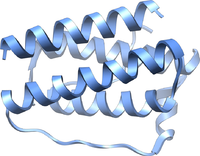
Photo from wikipedia
Background: Up to 80% of pancreatic cancer patients suffer from cachexia. White adipose tissue (WAT) browning caused by the tumorigenicity and progression aggravates the cancer-associated cachexia (CAC). Cancer-initiated changes in… Click to show full abstract
Background: Up to 80% of pancreatic cancer patients suffer from cachexia. White adipose tissue (WAT) browning caused by the tumorigenicity and progression aggravates the cancer-associated cachexia (CAC). Cancer-initiated changes in the protein-38 mitogen-activated protein kinases (p38 MAPK) pathway are likely involved in the development of CAC. Methods: p38 MAPK inhibitors, VCP979 or SB203580, were used in the in vitro and in vivo models of pancreatic cancer cachexia. Expression of uncoupling protein 1 (UCP1) in the p38 MARK pathway and the properties and level of white adipocytes were analyzed and correlated to browning, followed by immunohistochemistry and Western blotting validations. Changes in the volume and fat fraction of WAT in animals were monitored by magnetic resonance imaging (MRI). Results: The size of white adipocytes was increased after being treated with the p38 MAPK inhibitors, along with increase in the MRI-measured volume and fat fraction of WAT. Comparing two p38 MAPK inhibitors, the p38α subunit-specific inhibitor VCP979 had a better therapeutic effect than SB203580, which targets both p38α and β subunits. Conclusions: Blockade of p38 MAPK reduced the WAT browning that contributes to CAC. Thus, p38 MARK inhibitors can potentially be used as a therapy for treating CAC. Non-invasive MRI can also be applied to assess the progression and treatment responses of CAC.
Journal Title: Nutrients
Year Published: 2022
Link to full text (if available)
Share on Social Media: Sign Up to like & get
recommendations!